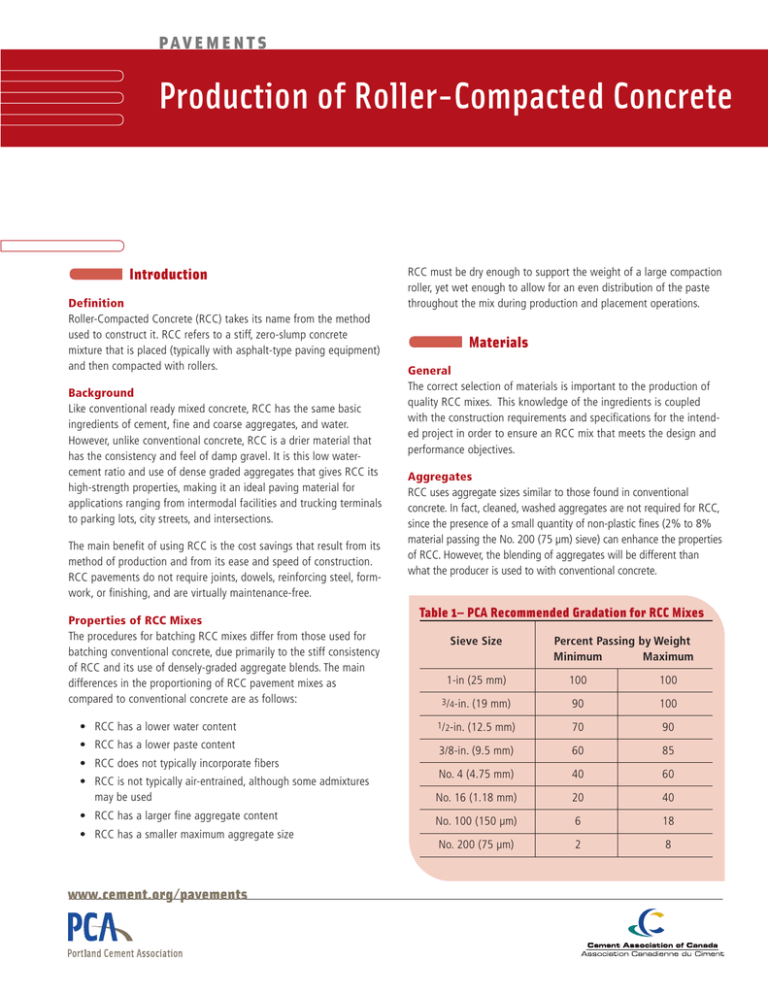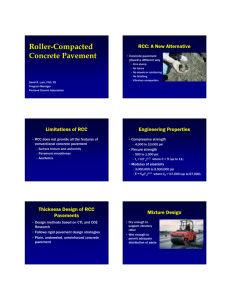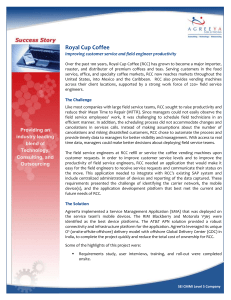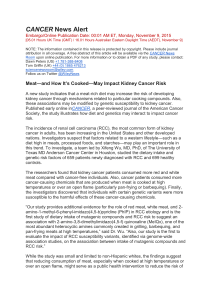
PAVEMENTS
Production of Roller-Compacted Concrete
Introduction
Definition
Roller-Compacted Concrete (RCC) takes its name from the method
used to construct it. RCC refers to a stiff, zero-slump concrete
mixture that is placed (typically with asphalt-type paving equipment)
and then compacted with rollers.
Background
Like conventional ready mixed concrete, RCC has the same basic
ingredients of cement, fine and coarse aggregates, and water.
However, unlike conventional concrete, RCC is a drier material that
has the consistency and feel of damp gravel. It is this low watercement ratio and use of dense graded aggregates that gives RCC its
high-strength properties, making it an ideal paving material for
applications ranging from intermodal facilities and trucking terminals
to parking lots, city streets, and intersections.
The main benefit of using RCC is the cost savings that result from its
method of production and from its ease and speed of construction.
RCC pavements do not require joints, dowels, reinforcing steel, formwork, or finishing, and are virtually maintenance-free.
Properties of RCC Mixes
The procedures for batching RCC mixes differ from those used for
batching conventional concrete, due primarily to the stiff consistency
of RCC and its use of densely-graded aggregate blends. The main
differences in the proportioning of RCC pavement mixes as
compared to conventional concrete are as follows:
• RCC has a lower water content
• RCC has a lower paste content
• RCC does not typically incorporate fibers
RCC must be dry enough to support the weight of a large compaction
roller, yet wet enough to allow for an even distribution of the paste
throughout the mix during production and placement operations.
Materials
General
The correct selection of materials is important to the production of
quality RCC mixes. This knowledge of the ingredients is coupled
with the construction requirements and specifications for the intended project in order to ensure an RCC mix that meets the design and
performance objectives.
Aggregates
RCC uses aggregate sizes similar to those found in conventional
concrete. In fact, cleaned, washed aggregates are not required for RCC,
since the presence of a small quantity of non-plastic fines (2% to 8%
material passing the No. 200 (75 µm) sieve) can enhance the properties
of RCC. However, the blending of aggregates will be different than
what the producer is used to with conventional concrete.
Table 1— PCA Recommended Gradation for RCC Mixes
Sieve Size
1-in (25 mm)
Percent Passing by Weight
Minimum
Maximum
100
100
(19 mm)
90
100
(12.5 mm)
70
90
3/8-in. (9.5 mm)
60
85
3/4-in.
1/2-in.
• RCC is not typically air-entrained, although some admixtures
may be used
No. 4 (4.75 mm)
40
60
No. 16 (1.18 mm)
20
40
• RCC has a larger fine aggregate content
No. 100 (150 µm)
6
18
No. 200 (75 µm)
2
8
• RCC has a smaller maximum aggregate size
www.cement.org/pavements
Coarse aggregates consist of crushed or uncrushed gravel, crushed
stone, or even crushed recycled concrete while the fine aggregates
consist of natural sand, manufactured sand, or a combination of the
two. Crushed aggregates typically work better in RCC mixes due to
the sharp interlocking edges of the particles, which help to reduce
segregation, provide higher strengths, and provide better aggregate
interlock at joints. Because up to 90% of the volume of a high-quality
RCC mix can be comprised of coarse and fine aggregates, their durability should be evaluated through standard physical property testing
such as those outlined in American Society for Testing and Materials
(ASTM) C 33 or Canadian Standards Association (CSA) A23.1.
The total amount of cementitious material consisting of cement and
pozzolan - often abbreviated as (C + P) - for an RCC mix is typically
between 400 and 600 pounds per cubic yard (240 and 360 kilograms
per cubic meter) in a wide range of proportions of these materials.
Admixtures
Chemical admixtures used in RCC mixes should conform to ASTM
C 494 and should be approved by the Project Engineer prior to use.
The addition of water-reducing or set-retarding (hydration-stabilizing) admixtures can delay the setting time of the cementitious
materials and may be useful when there is a long haul time between
the point of production and the project location. Water reducers have
been successfully used with RCC to help distribute the cement paste
uniformly throughout the mix and to improve workability during
paving. Polycarboxylate superplasticizers have been used in dry batch
plant production to improve workability and reduce mixing times,
resulting in significantly increased production rates. However, a pavement test section must be constructed to verify the proper admixture
to use for a particular mix.
The American Concrete Institute (ACI) has established aggregate
gradation limits that produce quality RCC pavement mixtures.
A detailed discussion on the selection and performance of aggregate
blends in RCC pavement mixes may be found in ACI 325.10R,
State-of-the-Art Report on Roller-Compacted Concrete Pavements(1).
These ACI gradation limits effectively allow the use of blends of
standard size coarse aggregate. From ASTM C 33, the most common
sizes used include No. 67, No. 7, No. 8, and No. 89.
Set-accelerating admixtures can also be used if the intent is to speed
the setting time of the RCC, such as when opening a project early to
traffic. Because of the dry nature of RCC and the difficulty of getting
uniform distribution, fibers are typically not used. Additionally,
air-entraining admixtures have not been used extensively in RCC,
since acceptable freeze/thaw durability can be achieved without air
entrainment(2). Entraining air at the mixing plant has also been found
to be difficult(3). Whenever any admixtures are being considered,
extensive laboratory and field testing should be conducted to determine the effectiveness and proper dosage rates.
ACI and the Portland Cement Association (PCA) recommend the
use of dense, well-graded blends with a nominal maximum size
aggregate not to exceed 1-inch (25 mm) in order to help minimize
segregation and produce a smooth finished surface. Gap-graded
mixes that are dominated by two or three aggregate sizes are not
desirable for RCC. Additionally, the recommended gradation calls for
a content of fine particles (2% to 8% passing the No. 200 (75 µm)
sieve) that is typically higher than that of conventional concrete. This
eliminates the need for washed aggregates in many cases and produces a mix that is stable during rolling.
Water
While the quantity of mixing water is considerably reduced for RCC,
its quality should meet the same requirements as for conventional
concrete mixes. The quantity of water is typically between 150 and
200 pounds per cubic yard (90 and 120 kilograms per cubic meter).
Water to total cementitious ratios - expressed as W/(C + P) - for RCC
pavement mixes generally fall between 0.30 and 0.45. W/(C + P)
ratios in this range have the greatest positive influence on the final
strength of the RCC, with 28-day unconfined compressive strengths
typically exceeding 6,000 psi (41 MPa).
In cases where washed aggregates are being used, it may be
difficult to meet the specification for 2% to 8% fine particles. In
cases like this, fly ash can be added to the mix to provide the desired
fines content. These fines provide lubrication that helps to distribute
the paste throughout the mix. However, these fines need to be
non-plastic, with their plasticity index not to exceed four.
In many cases, aggregates used in typical highway construction will
also meet the RCC gradation requirements mentioned above. Graded
aggregate base material, crusher run material, and aggregates for
hot-mix asphalt paving mixes can be used with little or no modification in RCC mixes.
Mix Design
General
Just as in material selection, the correct proportioning of the raw
materials is critical to the production of quality RCC mixes. The mix
design process should not be approached as one of trial and error,
but rather a systematic procedure based on the aggregates, water,
and cementitious materials used in the mix.
Cementitious Materials
The cementitious materials including cement and pozzolan used in
RCC mixes include Type I, Type IP, or Type II portland cement
(ASTM C 150) or blended hydraulic cement (ASTM C 595), Class F or
Class C fly ash (ASTM C 618), silica fume (ASTM C 1240), and ground
granulated blast furnace slag (ASTM C 989, or CSA A3001 for all
cementitious materials). The selection of the proper type and amount
of cementitious materials should be based on their availability as well
as the required design strength and durability of the finished RCC.
Several methods currently exist for proportioning RCC mixes for
pavements; however, there is not one commonly accepted method.
The main RCC proportioning methods include those based on
2
Production of Roller-Compacted Concrete
The optimal paste volume method has three major steps. The first
step is to select an aggregate gradation that contains a minimal
volume of voids for a given compaction energy. In the second step,
the volume of remaining voids is used to adjust the volumetric
dosage of paste in order to obtain the required workability. The third
and final step involves the selection of the W/(C + P) ratio and the
proportions of cement and any other cementitious materials that will
produce a paste with enough binding capacity to satisfy the strength
requirements of the project(5).
1) concrete consistency testing, 2) the solid suspension model,
3) the optimal paste volume method, and 4) soil compaction testing.
Whichever method is employed, the goal is to produce an RCC
mixture that has sufficient paste volume to coat the aggregates in the
mix and to fill in the voids between them(1).
Proportioning by Use of Concrete Consistency Tests
Proportioning methods that use concrete consistency tests normally
require the establishment of specific mixture parameters–such as the
amount of aggregate, the amount of water, or the amount of cementitious materials–and then adjust one of these parameters in order to
meet a required level of consistency, workability, or strength. By following this method, each ingredient in the mixture can be optimized
in order to obtain the desired fresh and hardened RCC properties.
Proportioning by Use of Soil Compaction Tests
This proportioning method involves establishing a relationship
between the density and moisture content of an RCC mix by compacting samples over a range of moisture contents as described in
the section of this document titled Moisture-Density Relationship.
Moisture-density tests are conducted and moisture-density curves are
established over a range of cementitious material contents. Strength
test specimens are then prepared by compacting specimens at the
optimum moisture content for each particular cementitious material
content. From these tests, a plot of strength versus cementitious
material content is established to select the minimum cementitious
materials content that will meet the design requirements(1).
In order to determine the sufficient minimal paste volume, a series of
trial mortar mixtures with varying water/binder and sand/cementitious
ratios is prepared and cast, measuring the density of each mixture.
For an established water/binder ratio, a certain sand/cementitious ratio
will result in the optimum mixture density. This water/binder ratio is
selected to meet the required design strength. After determining these
water/binder and sand/cementitious ratios, the coarse and fine aggregate proportions are adjusted in order to achieve a certain workability(4).
Moisture-Density Relationship
A moisture-density test is used to determine the optimum moisture
content and maximum density of RCC mixtures. The modified Proctor
compaction test (ASTM D 1557) is a common and familiar procedure
for most geotechnical and materials testing laboratories to perform.
Figure 1 shows a typical compaction curve from the modified Proctor
test. If the mix is too dry, there is not enough moisture available to
lubricate the particles into a denser formation. If the mix is too wet,
the excess moisture pushes the particles apart. The moisture content
at which maximum density is achieved should be selected for mix
design and field quality control.
Proportioning by Use of the Solid Suspension Model
In recent years, a more theoretical and fundamental approach to
RCC mix design proportioning has been introduced, called the solid
suspension model. This proportioning method is used to determine the
proportions of each of the dry solid ingredients (cement, fly ash, silica
fume, sand, and coarse aggregate) that optimize the dry packing density of a given RCC mixture. Using this optimized dry packing density,
the amount of water necessary to entirely fill the void spaces between
the dry ingredients can then be easily calculated.
By knowing certain material characteristics such as gradation,
specific gravity, and void content for each of the dry solid ingredients,
reliable computer simulations can be run using this model. In fact, the
systematic use of this proportioning method has yielded results very
similar to those obtained using the concrete consistency tests mentioned earlier. The main advantage of the solid suspension model is
that it can be used to recalculate very quickly the optimum proportions of an RCC mixture without having to prepare a large number of
laboratory trial batches(4).
For a given project, the objective of the moisture-density testing is to
establish a maximum unit weight of the RCC mix which will be used as
the target density to which the mix must be compacted. The optimum
moisture content will facilitate compaction and provide the best opportunity to achieve maximum compaction and density. Since density is an
important factor in the strength and durability of RCC, required minimum density levels are always included in project specifications.
Usually the requirement is a minimum of 98% of the maximum total
density. Because the moisture content in the field will typically not vary
much from optimum, most specifications will indicate required density
in terms of wet or total density.
Proportioning by Use of the Optimal Paste Volume Method
Originally developed to prepare RCC mixes for dams and other large
structures, the optimal paste volume method has lately been used for
the proportioning of non-air-entrained RCC pavement mixes as well.
Because the workability of an RCC mix is one of its main requirements, this method stresses a mix design that will meet specified
workability requirements. It is based on the assumption that an
optimal mix should have just enough paste to completely fill any
remaining voids after the aggregates have reached their maximum
density under compaction.
The most commonly used method to determine density in the field is
through the use of a nuclear density gauge. This device measures
both the wet density and the moisture content of RCC. However, the
moisture measurements made from nuclear gauges can be affected
by cement hydration, and should be verified with other methods of
determining water content. This effect on moisture content measurements is one reason most RCC construction specifications reference
3
wet density instead of dry density. Moisture content determination constitutes an important part
of RCC quality control because the information is
used in evaluating the compaction efficiency and
material behaviors; therefore, accurate moisture
measurement is critical.
Aggregates. With fine and coarse aggregates
comprising up to 90 percent of the volume of an
RCC pavement mix, the first step is to properly
choose the aggregates that will be used. The
dense, well-graded aggregates incorporated in
an RCC mix are selected based upon the recommended aggregate gradation specifications
previously mentioned.
144
Dry Density (lb/cf)
Proportioning by use of soil compaction testing
is the most commonly used method of mix
design and is further explained in detail in the
sections following.
Moisture-Density Relationship
Maximum Dry
Density
143
2275 kg/m3
142
Optimum Moisture
Content
141
2250 kg/m3
140
2
3
4
5
6
7
8
Moisture Content (percent)
Figure 1—Typical Moisture-Density Curve for RCC Mixes.
Water. The second step is to select the proper
water (moisture) content for the RCC mix. Unlike conventional concrete, the W/(C + P) ratio is not used as the primary design objective.
It is important to remember that water content is based on the
maximum compaction density of the RCC mix and the construction
requirements of the project. Water content is also dependent on the
use of chemical admixtures.
tious materials to be incorporated into the RCC mix. Prepared
samples (cylinders) are cast and tested for compression (ASTM C 39)
and splitting tensile strength (ASTM C 496, or CSA A23.2 for both)
in accordance with the project specifications. Specifications relating
to flexural strength (or modulus of rupture) are usually converted to
equivalent estimates based on compressive strength.
Cementitious content (c + p) may occasionally be expressed in terms
of percentage of the mixture rather than in pounds per cubic yard
(kg/m3). When this is the case, the percent of cementitious material
(by weight) is based on the total solids in the mixture and is determined as follows:
The water content (w) is usually expressed as a percentage
(by weight) of the total solids in the mix:
water content, w (%) =
weight of water in mix
X 100
weight of oven-dry aggregates + cementitious material
cementitious content, c + p (%) =
weight of cementitious material in mix
X 100
weight of oven-dry aggregates + cementitious material
For quality control purposes, it is important that the producer monitor
the moisture of aggregates in bins and stockpiles. The amount of
water added at the plant will depend upon the amount of moisture
(above oven-dry) already in the aggregate stockpiles. [Note that the
moisture content is based on
oven-dry aggregates and not
saturated surface dry aggregates,
State
Oven-dry
which are typically referenced in
conventional concrete.] Water
should be adjusted accordingly
at the plant so that the moisture
conditions of the aggregate
accurately meet the water
requirements of the RCC mix(6).
Total
None
Cementitious Materials.
The third and final step is to select
the proper amounts of cementi-
2300 kg/m3
Air-dry
Less than
potential
absorption
moisture:
Saturated
surface dry
Equal to
potential
absorption
Damp
or wet
Greater
than
absorption
Figure 2—Moisture Conditions of Aggregate.
4
Production of Roller-Compacted Concrete
Figure 5—Stationary Tilt Drum Mixer.
Figure 3—Preparing RCC Samples According to ASTM C 1435.
Figure 6—Mobile Truck Mixer.
Figure 4—Cured RCC Samples.
• Mobile Truck Mixers—Versatility and speed are advantages of mobile truck mixers since all components–aggregates,
cement, and water–are stored in separate compartments on
the truck unit.
Cylinder Preparation
Because RCC is very stiff, dry-rodding of concrete cylinders provides
inadequate consolidation; therefore, RCC cylinders are prepared
using either the modified Proctor procedure (ASTM D 1557) or the
vibratory hammer method (ASTM C 1435).
Production
Mixing Equipment
RCC can be produced in any type of equipment that will provide
uniform mixing of the cement, aggregates, and water. Obviously,
the size and nature of the project will dictate which production
method to use.
• Transit Mixers—While transit mixers (either standard or
front-discharge) are capable of producing a quality product and
providing more local availability of RCC, their slower mixing and
discharge times are tailored for production on a smaller scale.
• Tilt Drum Mixers—By far the most common central mixing
unit, tilt drum mixers (either portable or permanent) have
regional availability coupled with fast, quality-consistent production capabilities, making them suitable for most RCC projects.
Figure 7—Continuous Flow Pugmill Mixer.
5
• Horizontal Shaft Mixers—Whether single-shaft or
dual-shaft, portable or permanent, continuous flow (as in
a pugmill) or compulsory batch, spiral ribbon or paddle,
horizontal shaft mixers provide the most intense and fastest
mixing action, making them the best choice for larger and
high production-oriented projects.
Batching and Mixing
The required mixing time for RCC will depend on a number of
factors including the size of the batch, the gradation of the mix,
the W/(C + P) ratio, and the type of mixing equipment employed.
Because of the very dry consistency of RCC, the batch volume of
mixed material for transit and tilt drum mixers is oftentimes less
than the manufacturer's rated capacity of the mixer for conventional concrete. Sample mixing times and maximum batch sizes for five
types of mixing units are summarized in Table 2.
For larger RCC paving projects, the horizontal shaft mixers are
most commonly used because they are easily transported and
erected at the job site, can produce a relatively large amount of
material, and provide excellent mixing efficiency. For smaller
projects, tilt drum mixers, transit mixers, and mobile truck mixers
are sufficient. The central mix plant that produces the RCC mix
should be located as near to the paving project as possible in order
to minimize haul time.
Figure 8—View of Pugmill Mixing Chamber.
Whichever mixing method is employed, it is imperative that RCC
be mixed vigorously in order to evenly distribute the small
amount of water present in the mix. Because of its zero-slump
and low paste content, the key to producing a strong, durable
RCC mix rests in the careful proportioning and vigorous mixing of
all the ingredients.
Successfully proportioned and mixed RCC looks and feels like damp
gravel. Proper moisture content is critical to achieve adequate
compaction and long-term performance. Acceptable moisture contents can vary within a narrow range of plus or minus 1/2 percent.
To monitor the moisture content at the plant, samples of the mixed
RCC should be tested as part of routine quality control.
Figure 9—Portable Horizontal Shaft Batch Mixer.
Table 2—Recommended Mixing Times and Batch Sizes for RCC.
Mixer Type
Mixing Time
Batch Size
Transit
4 to 5 minutes *
70% to 100% of drum capacity
Tilt Drum
2 to 4 minutes
70% to 100% of drum capacity
Horizontal Compulsory
20 to 60 seconds
up to 12 yd3 (9.2 m3)
Mobile Truck Mixer
Continuous
12 yd3 (9.2 m3) capacity; variable production
up to 75 yd3 (57 m3) per hour
Horizontal Continuous Flow
Continuous
up to 250 yd3/hr (190 m3/hr)
* assuming a mixing speed of 20 revolutions per minute
6
Production of Roller-Compacted Concrete
Production Levels
The construction sequences from production to
compaction must be coordinated so that there is a
continuous operation with no delays in any of the
construction phases. Mixing, transporting, placing,
and compaction must be planned accordingly. It is
extremely important that the rate of RCC production
at the plant be able to keep up with the speed of
construction at the site, as a continuous supply of
fresh RCC material to the pavement placement
machinery is necessary in order to produce a quality
product. If production does not keep pace with
construction, the stopping and starting actions of the
paving machinery can potentially result in problems
with segregation of material, surface undulations,
inadequate compaction, and poor final ride quality.
As an example, consider the rate of plant production
that would be necessary in order to keep up with the
following field paving operations:
Figure 10—RCC Loaded into Truck for Delivery to Project.
• pavement width = 20 feet (6.1 m)
• pavement thickness = 8 inches (200 mm)
References
• unit weight of RCC material = 150 pounds per cubic foot
(2400 kg per cu m)
Bibliography
• speed of paving operations = 4 feet (1.2 m) per minute
1. ACI Committee 325.10 Report, “State-of-the-Art Report on Roller
Compacted Concrete Pavements”, ACI Manual of Concrete
Practice, 1995.
[(20 ft)(8 in)(150 pcf)(4 fpm)(60 min)] = 480,000 pounds
(218,000 kg) per hour
= 240 tons
(218 metric tons) per hour
(or 120 cu yd (92 cu m)
per hour)
2. Piggott, R. W., Roller-Compacted Concrete Pavements—A Study
of Long Term Performance, RP366, Portland Cement Association,
1999.
3. Service d'Expertise en Materiaux Inc., Frost Durability of RollerCompacted Concrete Pavements, RD135, Portland Cement
Association, 2005.
Using this example, the rate of RCC production at the plant would
have to be at least 120 cubic yards (92 cubic meters) per hour
in order to keep the paving equipment in the field moving at a
constant speed.
4. Marchand, J., Gagné, R., Lepage, S., and Ouellet, E., Mixture
Proportioning of Roller-Compacted Concrete for Dams and
Pavement Construction, Proceedings, Third CANMET/ACI
International Symposium on Advances in Concrete Technology,
1997.
Transportation
General
Regardless of the mixing and batching method chosen, the RCC mix is
almost always transported to the job site in dump trucks. These dump
trucks should be equipped with covers in order to protect the RCC mix
from the elements and to ensure efficient placement. While RCC can
be produced directly into dump trucks from tilt drum and horizontal
shaft mixers, the use of transit mixers involves the additional step of
discharging into a dump truck for delivery. Because of the very dry
consistency of RCC, the use of fluidizing admixtures is recommended
when mixing or hauling RCC in transit mixers.
5. Gagné, R., “Mixture Proportioning of Non-Air-Entrained RCC for
Pavements”, Concrete International, Vol. 21, No. 5, 1999.
6. Portland Cement Association, Design and Control of Concrete
Mixtures, EB001, 2002.
7
ASTM Standards
C 33
Specification for Concrete Aggregates
C 39
Test Method for Compressive Strength of Cylindrical
Concrete Specimens
Further Help
For assistance with your RCC project, visit the PCA web site at
www.cement.org/rcc. Also, the following useful publications can be
ordered through the web site or by calling PCA Publications at
800.868.6733.
C 150
Specification for Portland Cement
The Right Choice for Tough Duty (PL397)
C 494
Specification for Chemical Admixtures for Concrete
C 496
Test Method for Splitting Tensile Strength of Cylindrical
Concrete Specimens
C 595
Specification for Blended Hydraulic Cements
C 618
Specification for Coal Fly Ash and Raw or Calcined Natural
Pozzolan for Use as a Mineral Admixture in Concrete
C 989
Specification for Ground Granulated Blast-Furnace Slag for
Use in Concrete and Mortars
C 1240 Specification for Use of Silica Fume as a Mineral Admixture
in Hydraulic Cement Concrete, Mortars, and Grout
Roller-Compacted Concrete Pavements—A Study of Long Term
Performance (RP366)
Structural Design of Roller-Compacted Concrete for Industrial
Pavements (IS233)
RCCPave (Computer Program Software for Thickness Design of
Roller-Compacted Concrete Pavement) (MC043)
The Right Choice for Tough Duty (Video on mini-CD, CD034)
(Video in VHS Format, VC396)
Frost Durability of Roller-Compacted Concrete Pavements (RD135)
C 1435 Practice for Molding Roller-Compacted Concrete in Cylinder
Molds Using a Vibrating Hammer
Guide Specification for Construction of Roller-Compacted Concrete
Pavements (IS009)
D 1557 Test Methods for Laboratory Compaction Characteristics of
Soil Using Modified Effort
Roller-Compacted Concrete Density: Principles and Practices (IS541)
CSA Standards
A23.1
Concrete Materials and Methods of Concrete Construction
A23.2
Methods of Test and Standard Practices for Concrete
A3001
Cementitious Materials for Use in Concrete
Frost Durability of Roller-Compacted Concrete Pavements: Research
Synopsis (IS692)
Portland Cement Association ("PCA") is a not-for-profit organization and
provides this publication solely for the continuing education of qualified
professionals. THIS PUBLICATION SHOULD ONLY BE USED BY QUALIFIED
PROFESSIONALS who possess all required license(s), who are competent
to evaluate the significance and limitations of the information provided
herein, and who accept total responsibility for the application of this information. OTHER READERS SHOULD OBTAIN ASSISTANCE FROM A QUALIFIED PROFESSIONAL BEFORE PROCEEDING.
PCA AND ITS MEMBERS MAKE NO EXPRESS OR IMPLIED WARRANTY
WITH RESPECT TO THIS PUBLICATION OR ANY INFORMATION
CONTAINED HEREIN. IN PARTICULAR, NO WARRANTY IS MADE OF
MERCHANTABILITY OR FITNESS FOR A PARTICULAR PURPOSE. PCA AND
ITS MEMBERS DISCLAIM ANY PRODUCT LIABILITY (INCLUDING WITHOUT
LIMITATION ANY STRICT LIABILITY IN TORT) IN CONNECTION WITH THIS
PUBLICATION OR ANY INFORMATION CONTAINED HEREIN.
www.cement.ca
An organization of cement companies to
improve and extend the uses of portland
cement and concrete through market
development, engineering, research,
education, and public affairs work.
www.cement.org/pavements
© 2006 Portland Cement Association
All rights reserved
IS332





